5 Cheap And Delicious Dinners To Make This Week
Each recipe serves two hungry people with too much self-respect to survive on ramen and Easy Mac.

Use the grocery list below to make the five dinner recipes in this post over the course of a week in whatever order you like.
Your safest bet is to make them all within a week of grocery shopping to ensure that the ingredients stay fresh. It's not the biggest deal if you do it over the course of 10 days or so, but know that your cilantro probably won't last that long — though if you store it with the stems in water (like flowers) in the fridge, it might). Keep your meat in the freezer whether you cook this over a week or 10 days, but put it in the fridge two days before you plan to use it.
Also, though the recipes call for lots of the same ingredients, no recipe calls for leftovers from another. So, you can cook them in any order.
Here are all the groceries you'll need to cook these five dinners:
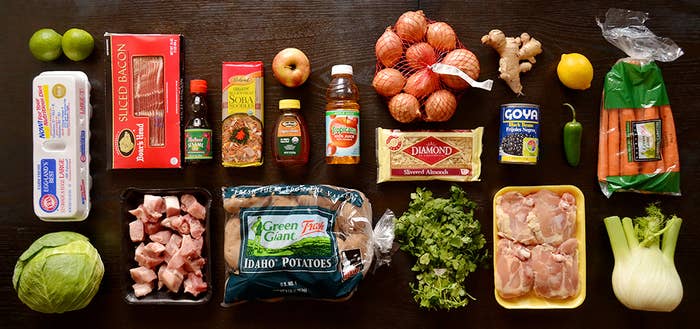
Pssst... I'm assuming you have olive oil, kosher salt, and freshly ground pepper.



PRODUCE
Gala apple, $.89
Green Cabbage, $1.99
Carrots, 1 pound, $.99
Fennel, $2.49
Ginger root, 1/4 pound, $.89
Cilantro, 1 bunch, $.99
Lemon, $.69
Limes, 2, $.66
Onions, 3 pound bag, $1.99
Jalapeno pepper, $.19
Russet potatoes, 5 pound bag, $3.49
MEAT
Bacon, 16 ounce package, $4.49
Chicken thighs, 4 (1 1/2 pounds), $3.43
Pork stew meat, 1 pound, $4.99
DAIRY
Eggs, dozen, $1.69
BEVERAGES
Apple Juice, 15.2 ounce bottle, $1.49
PANTRY STAPLES
Soba noodles, 12 ounces, $2.79
Black beans, 15.5 ounce can, $1.09
Sliced almonds, 2.25 ounce bag, $2.49
Sesame seed oil, 5 ounces, $5.99
Honey, 12 ounces, $3.99
Soy Sauce, 10 ounces, $2.49 (not pictured)
GROCERY TOTAL: $50.19 (based on Indianapolis, IN prices at peapod.com)
Certain key steps are photographed below each recipe to help make sure you're on the right track.
Sometimes, it can be frustrating when a recipe tells you to cook the onions until they're soft, or toast almonds until slightly browned and fragrant. Because, really, what does that mean? The pictures are included below to help you out with those slightly confusing steps, but they are not meant as an in-depth, step-by-step guide to the entire recipe.

Jalapeño Chicken Thighs with Black Beans and Honey-Lime Glazed Carrots
Serves 2
Recipe by Teri Tsang Barrett
INGREDIENTS
Extra-virgin olive oil
5 tablespoons honey, divided
1/4 cup lime juice (from 2 limes), divided
1 jalapeño, roughly chopped
Kosher salt and freshly ground pepper
2 large bone-in, skin-on chicken thighs (about 3/4 pound)
1/2 onion, finely chopped
1 15 ounce can black beans, rinsed and drained
2 tablespoons chopped cilantro, divided
2 medium carrots (about 8 ounces), peeled and sliced on the diagonal 1/3-inch thick
PREPARATION
Combine 1/4 cup olive oil, 3 tablespoons honey, 2 tablespoons lime juice, the
jalapeño and 1 teaspoon salt in a small food processor* (if you don't have one, see below) and puree until smooth. Pour into a quart-size resealable plastic bag, then add the chicken. Massage the bag to coat the chicken with the marinade, then refrigerate for at least 1 hour or up to overnight.
Preheat the oven to 450˚F. Heat 1 tablespoon olive oil in a small saucepan over
medium heat until hot. Add the onion and cook until softened, about 5 minutes.
Stir in the beans, 3/4 cup water, 1 tablespoon lime juice, 1/2 tablespoon cilantro
and 1/2 teaspoon salt. Cook, stirring occasionally, until the beans break down,
mashing as desired, about 20 minutes. Cover to keep warm; if needed, reheat
over low heat before serving and thin with a spoonful or two of water.
While the beans are cooking, set a rack on top of a baking sheet. Remove the chicken from the marinade, arrange on the rack and season with salt. Roast in the oven until charred in spots and cooked through, about 30 minutes. Let stand for 10 minutes, then serve with the carrots and black beans.
While the chicken is in the oven, heat 1 tablespoon olive oil in a 12-inch skillet
over medium-low heat. Add the carrots, season with salt and cook, stirring
occasionally, until al dente (they should be just tender on the outside), about 5 minutes. Add 1/4 cup water, the remaining 2 tablespoons honey and 1 tablespoon
lime juice and cook, stirring occasionally, until the carrots are fork-tender and the
liquid has cooked off, about 20 minutes. Toss with the remaining 1 tablespoon
cilantro and season with salt and pepper.
*If you don't have a food processor just chop the jalapeño as small as possible and whisk the oil, honey, lime juice, jalapeño, salt and pepper together by hand.
Your chicken should be coated as evenly as possible in the marinade.
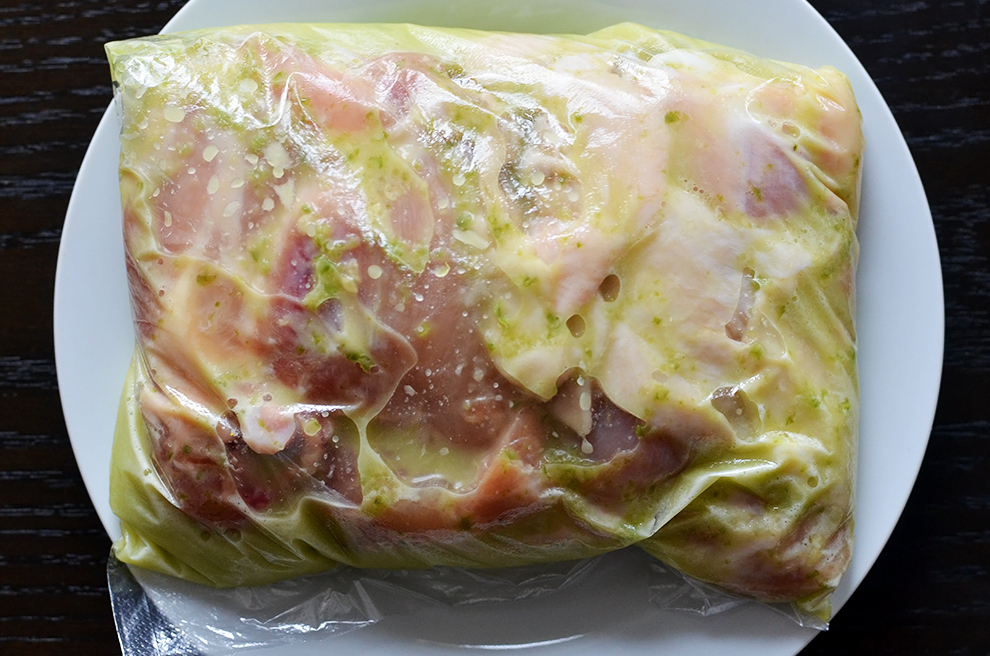
Don't add the beans, cilantro and lime juice until your onions are soft and just slightly browned, like this:
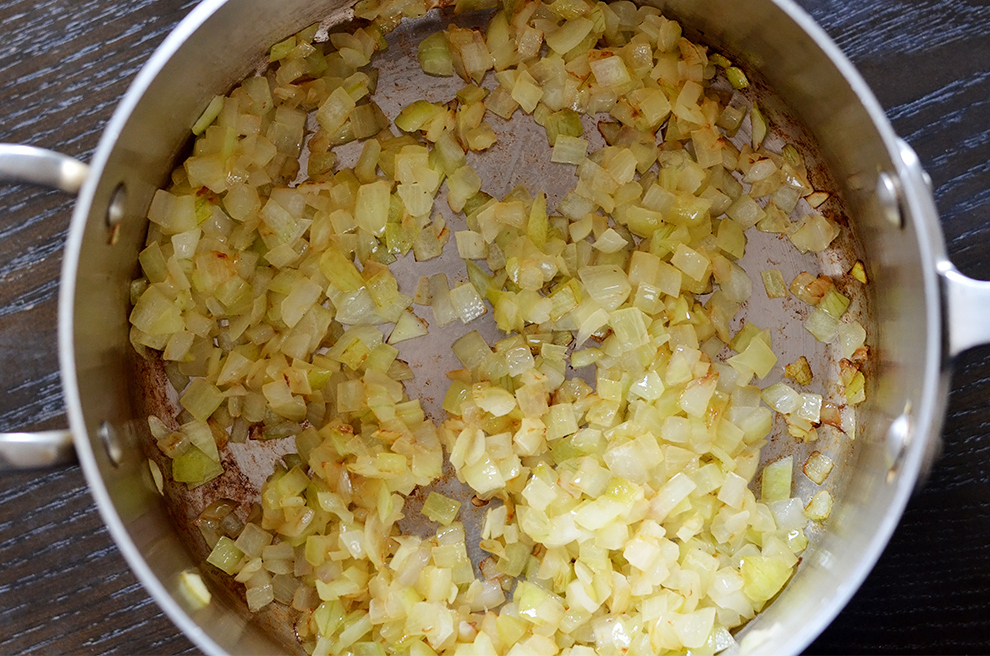
It's really up to you how much to cook your beans, but I suggest 20 minutes, covered.
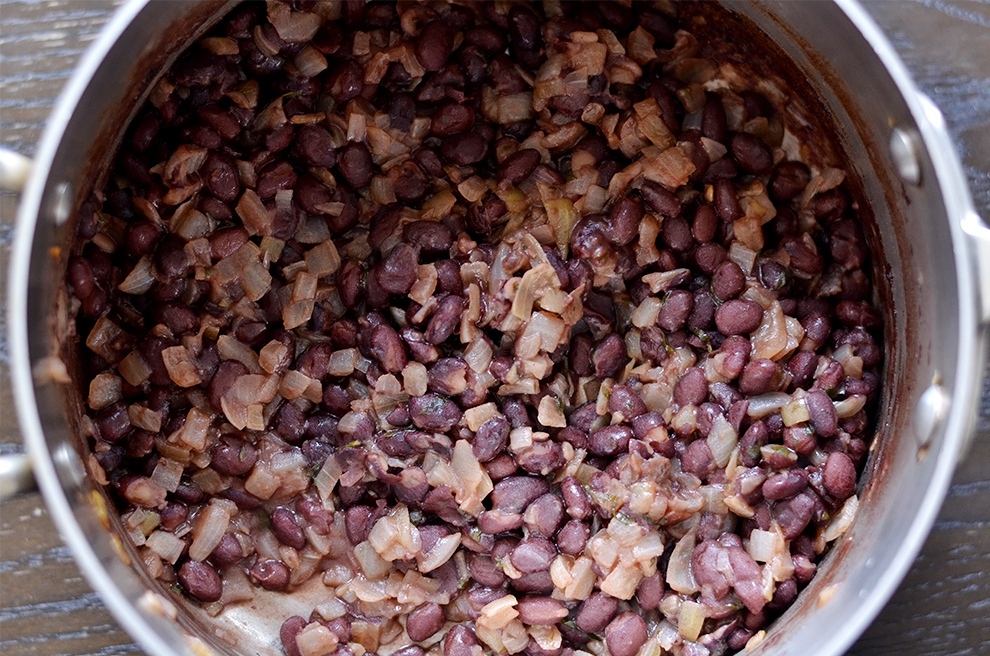
When you cook the chicken thighs, make sure they're not touching.
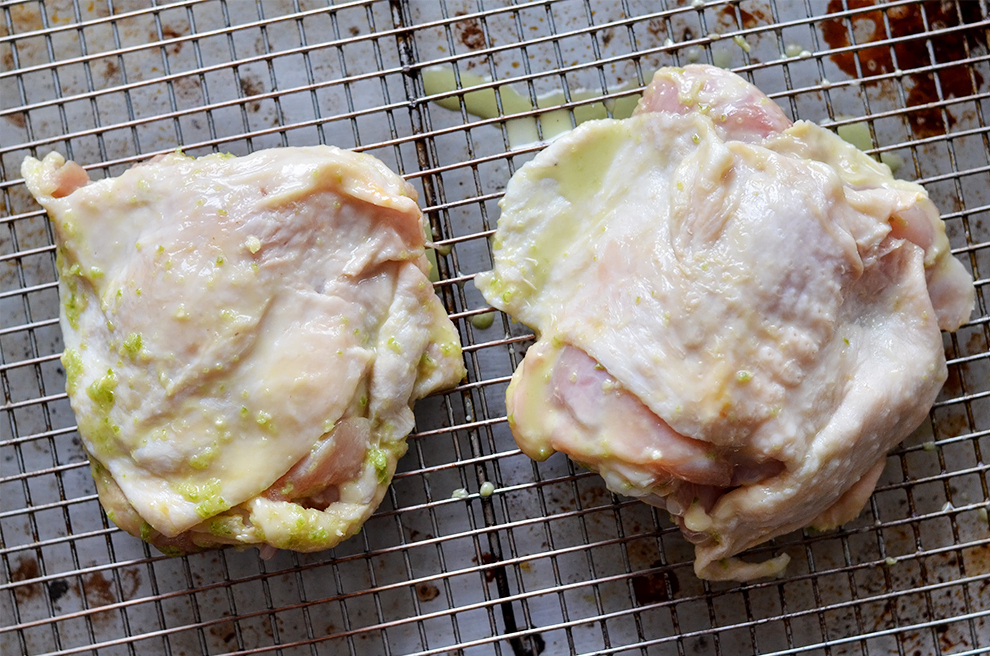
Before you add the honey, lime juice and water to the carrots, they should be just starting to soften, without any color.

After you add the honey, lime juice, and water, cook them just until all of the liquid has evaporated. Any longer and the honey will start to burn the bottom of the pan.
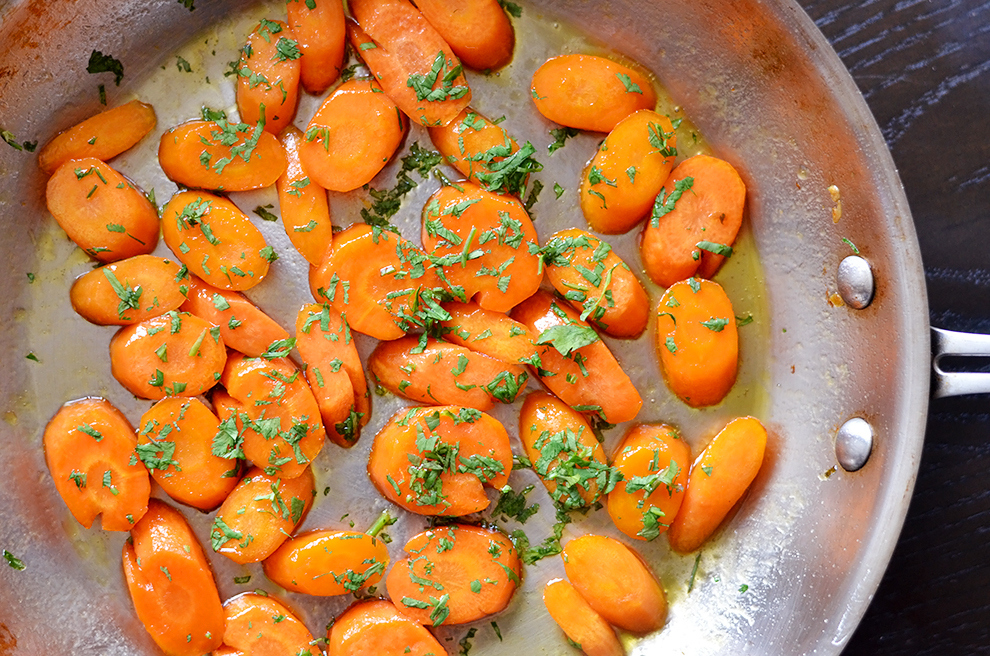
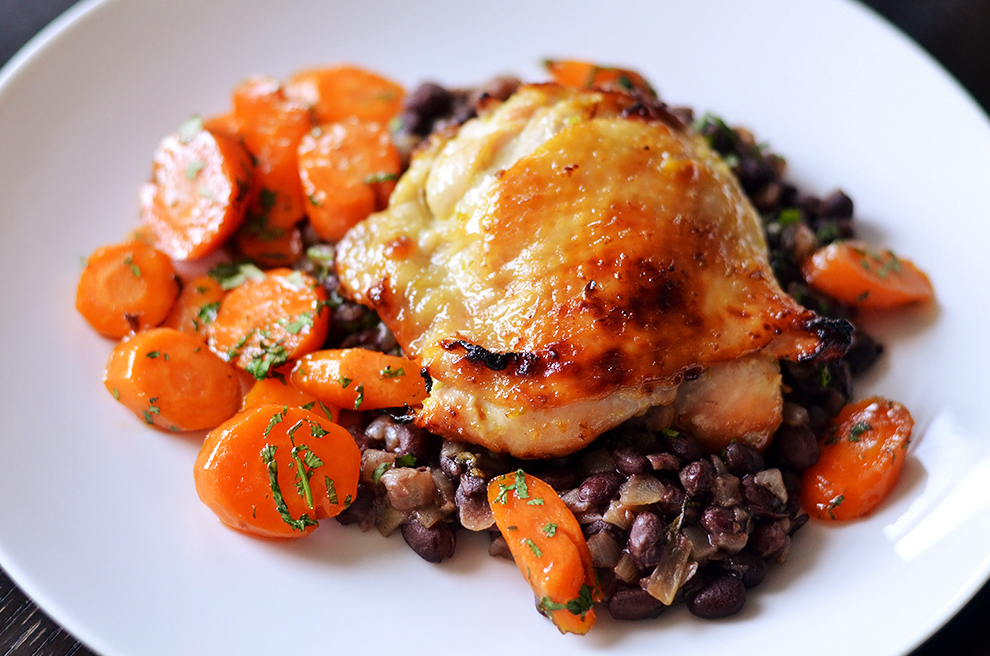
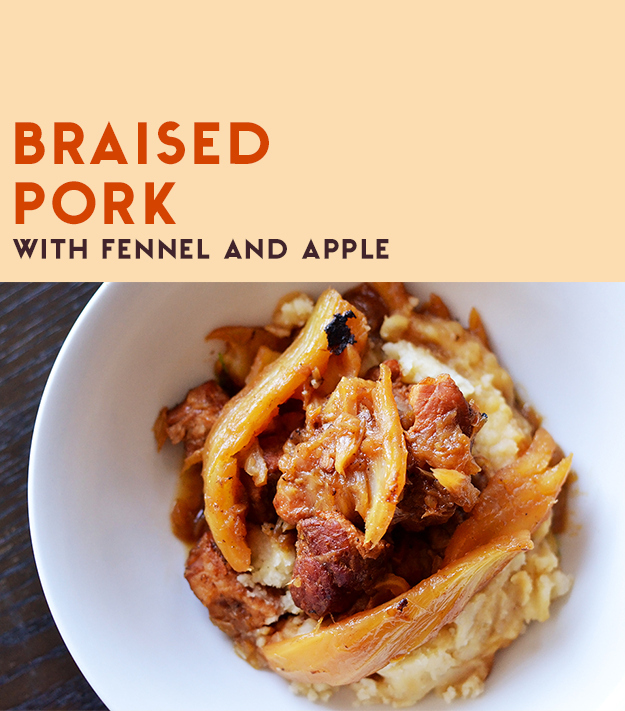
Braised Pork with Fennel and Apple
Serves 2
Recipe by Teri Tsang Barrett
INGREDIENTS
1 bulb fennel, trimmed, halved lengthwise and cored, plus chopped leafy fronds
for sprinkling
Extra-virgin olive oil
1 pound pork stew meat or boneless pork shoulder/butt, cut into 1 1/2-inch pieces
Kosher salt and freshly ground pepper
1 onion, diced
1 apple — peeled, cored and cut into 10 to 12 wedges
1 cup apple juice
1 pound small russet potatoes (about 3)
PREPARATION
Position the fennel halves, cut-side down, on a cutting board. Thinly slice the
bulbs lengthwise 1/4-inch thick (see photos below for what this should look like); do not separate the segments if attached at the core. Set aside.
Coat the bottom of a dutch oven with olive oil (about 2 tablespoons for a 5-
quart pot) and place over high heat. Season the pork with salt and pepper. Once
the oil is hot (a drop of water will cause the oil to spit and sizzle when it's ready),
add the pork in an even layer without overcrowding the pan (do this in batches, if
needed) and cook until browned in spots on all sides, about 12 minutes; transfer
to a bowl.
Immediately add the onion and fennel to the pan, season with salt and cook,
stirring, until the pan is dry with lots of browned bits collected on the pan, 2 to 3
minutes. Deglaze the pan by adding about 1/4 cup water and scraping up all the
browned bits from the bottom. Cook, stirring occasionally, until the onion has
softened and the liquid has cooked off, about 5 minutes. Return the pork and
any juices to the pan along with the apple wedges, apple juice and about 3/4 cup water; submerge the pork in the liquid so that the tops are barely showing, adding more water if needed. Taste the liquid and season to taste with more salt and pepper.
Bring to a boil over high heat, then lower the heat to a simmer, cover and cook,
stirring every 30 minutes or so and re-submerging the meat, until the pork easily
falls apart when pierced with a fork, 1 hour 45 minutes to 2 hours.
About 20 minutes before the pork is done, peel and cut the potatoes into 1-
inch cubes. Place in a saucepan with 1 teaspoon salt and cover with water by
1 inch. Bring to a boil over high heat, then lower the heat to a simmer and cook
until easily pierced with a fork, 10 to 12 minutes. Drain, then return the potatoes
to the same saucepan. Drizzle with 2 tablespoons olive oil and about 1/4 cup of the liquid from the pork stew. Put the saucepan over low heat, and use a potato masher or fork to mash, over low heat, to desired consistency.
Divide the mashed potatoes between two shallow bowls or pasta plates, then
top with the pork mixture. Sprinkle with the fennel fronds.
When you brown meat, it's so important that you don't crowd the pan.
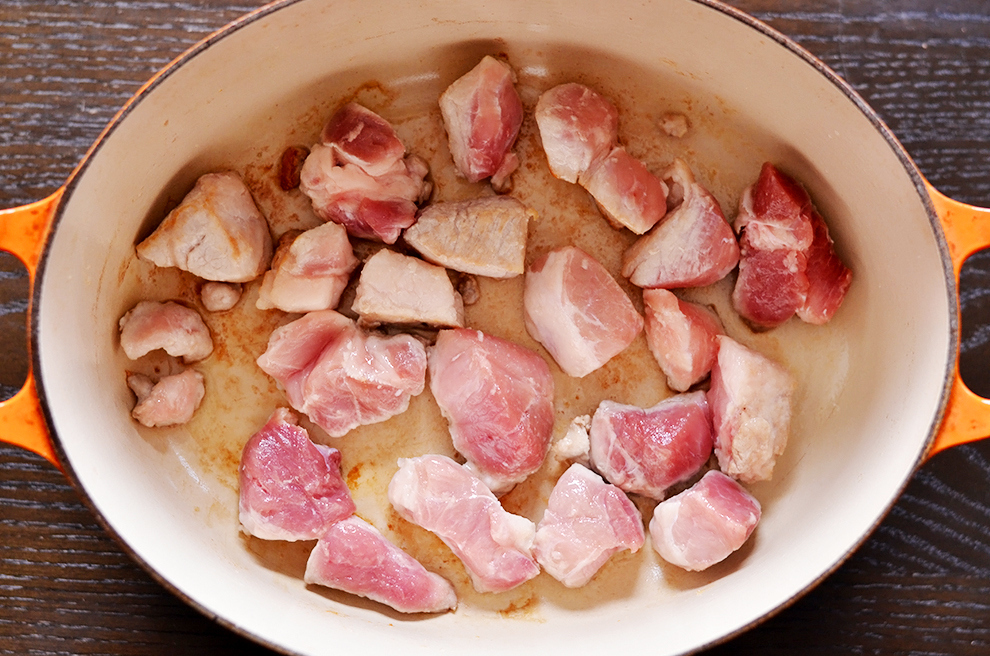
Because, uncrowded pan = fantastic caramelization (meaning, FLAVOR).
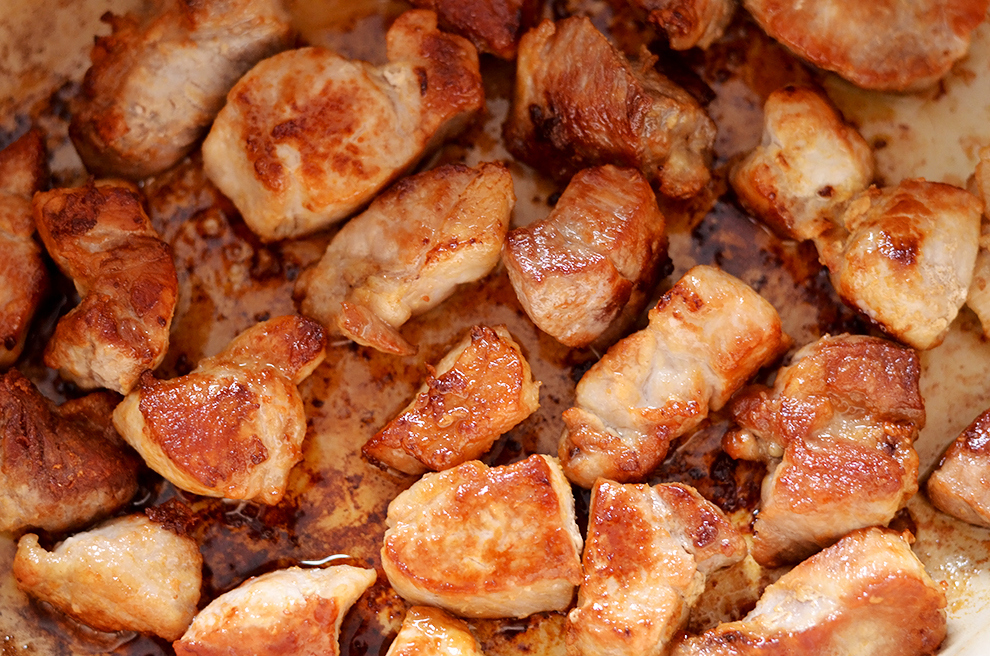
When you add the vegetables, you can crowd them a little bit more, but not too much.
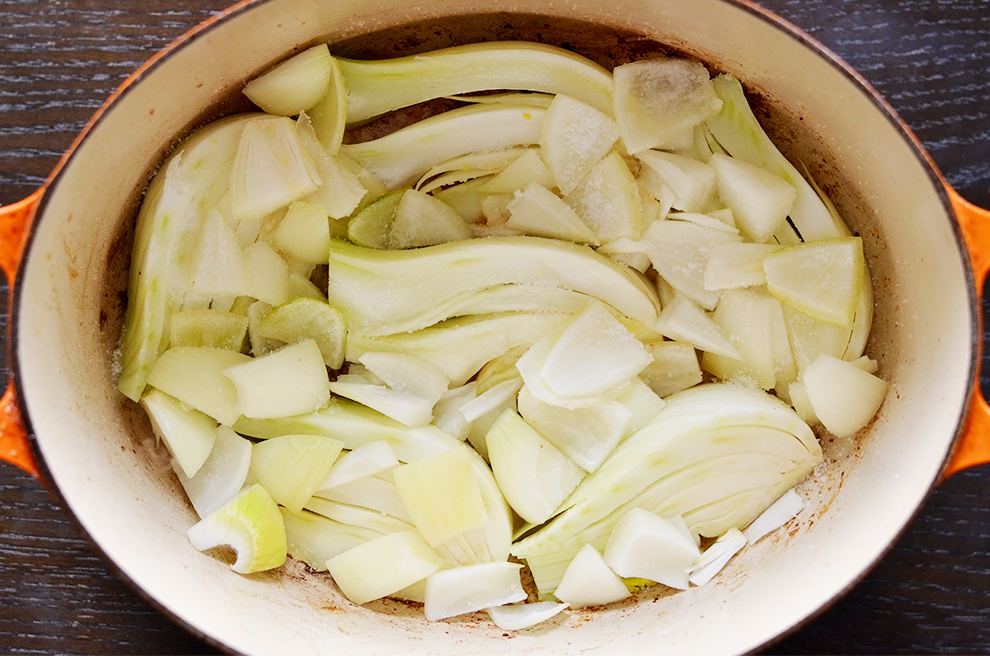
You still want them to caramelize a little as they soften.
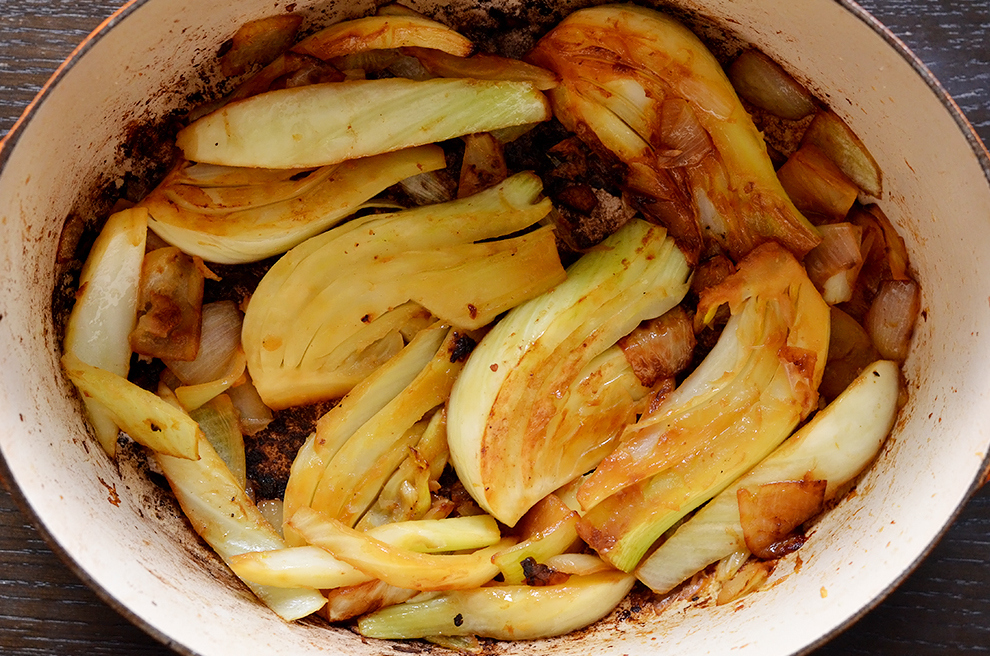
When deglazing, just add a little bit of water, push the vegetables aside, and use a spoon or spatula to scrape up the dark bits that are sticking to the bottom of the pan.

When you add the pork, apples, and juice, add just enough water to cover most, not all of the pork.
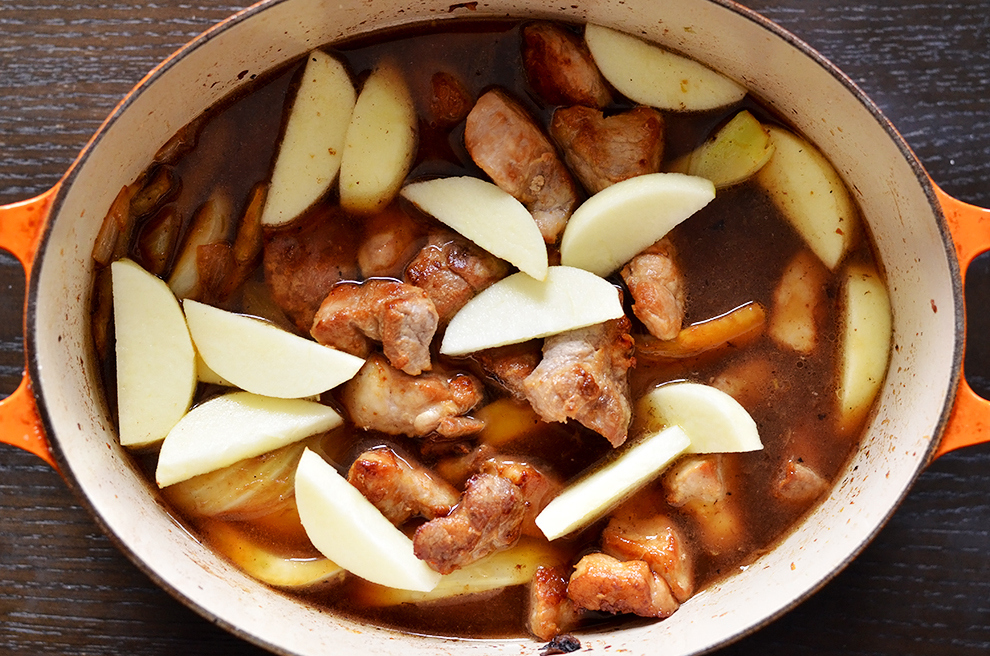
When boiling potatoes, be sure to only cover them with an inch of water. Any more, and it'll take forever to boil.
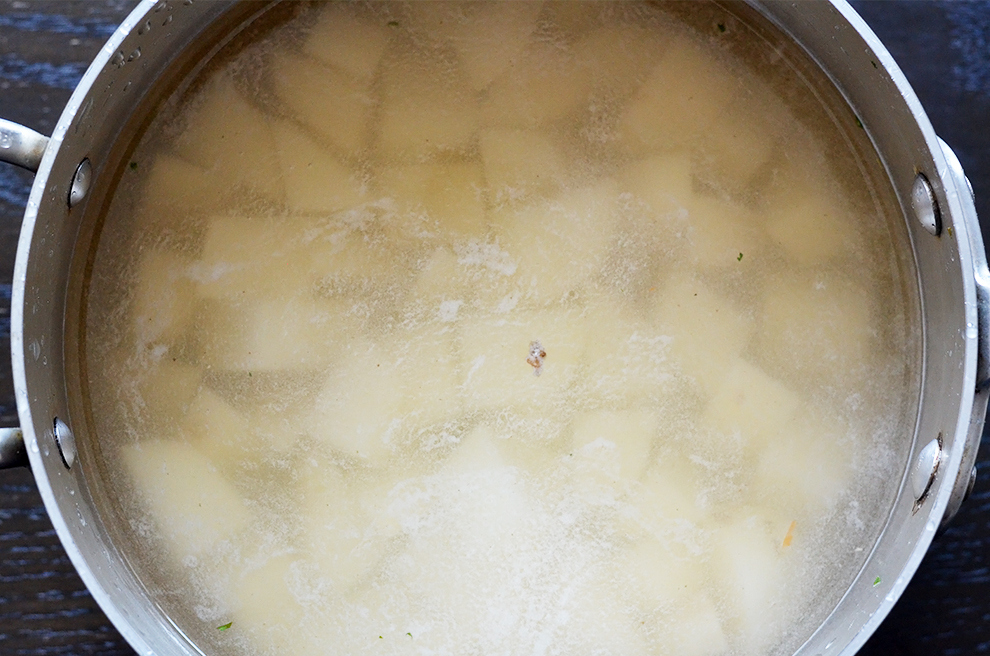
After you've drained the cooked potatoes and heated them back up in the pan, they should be fairly dry.
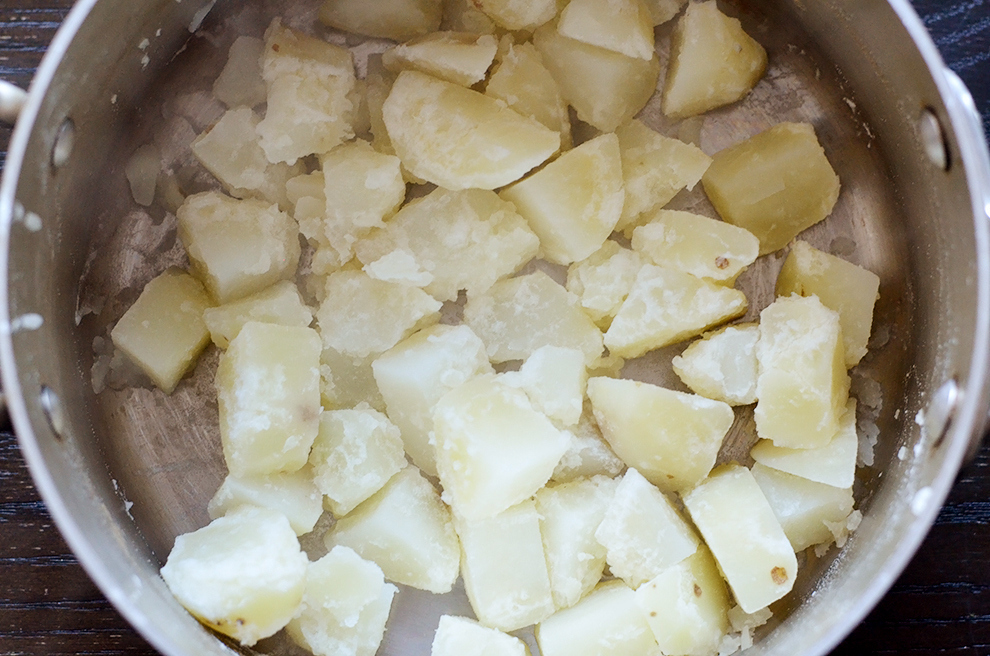
Add enough olive oil and braising liquid to the potatoes so that they mash easily, but don't worry that they're still a little dry.

When your stew is done, the liquid will have darkened, the fennel will be super soft, and the pork will be easy to pull apart with a fork.
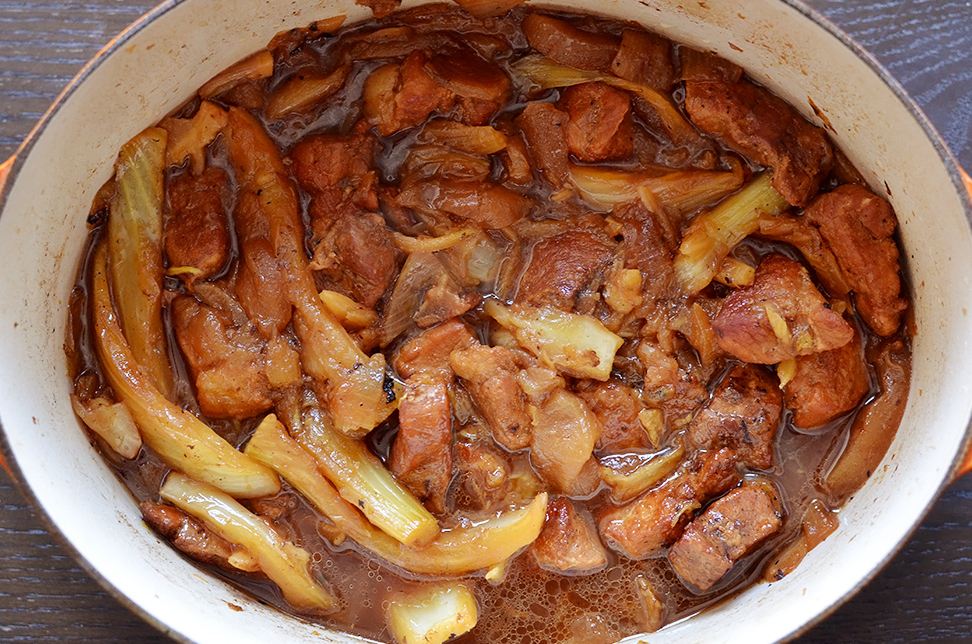


Asian Chicken Salad with Sesame Vinaigrette
Serves 2
Recipe by Teri Tsang Barrett
INGREDIENTS
1 2-inch knob of ginger
Extra-virgin olive oil
2 1/2 tablespoons sesame oil, divided
3 tablespoons soy sauce, divided
2 large bone-in, skin-on chicken thighs (about 3/4 pound)
2/3 cup sliced almonds
1/2 head green cabbage, cored and sliced very thin
2 carrots sliced very thin or grated on a grater with large holes (about 1 cup)
3 tablespoons lemon juice (from 1 lemon), divided
2 teaspoons honey, divided
2 tablespoons roughly chopped cilantro leaves
PREPARATION
Peel the ginger: Hold the knob in one hand, then hold a spoon in the other
hand and use the edge of the spoon to scrape off the ginger peel. Finely grate the ginger; you will need about 3 teaspoons.
Scrape 1 teaspoon of grated ginger into a resealable plastic bag (set the rest aside), then add 1 tablespoon each of the olive oil, the sesame oil and the soy sauce. Add the chicken and squish up the bag to coat the chicken with the marinade. Refrigerate the bag, turning occasionally, for at least 1 hour and up to overnight.
Preheat the oven to 450˚F. Set a rack on a rimmed baking sheet and arrange the chicken on top. Roast until crisp and cooked through, about 30 minutes. Let rest for 10 minutes.
While the chicken is roasting, heat a medium or large skillet over medium-high heat.
Add the almonds and toast, shaking the pan frequently to move the almonds around, until fragrant and the nuts are beginning to color, 5 to 7 minutes. Remove from the heat and set aside.
Put the cabbage and carrots in a large mixing bowl. In a small bowl, make the
dressing: Whisk together the lemon juice, the remaining 2 tablespoons soy sauce
and 2 teaspoons grated ginger, and the honey; gradually whisk in 2 tablespoons
olive oil and 1 1/2 tablespoons sesame oil. When the chicken is done and resting,
pour the dressing over the cabbage mixture and toss well, then season with salt. Add
the almonds and cilantro and toss again.
Remove the bone from each thigh, then slice as desired.
Divide the cabbage mixture between two serving plates, then top each plate
with one sliced chicken thigh.
Peeling ginger with a spoon is so much easier than using a peeler. Just use the edge of the spoon to scrape the skin.

It's easier to keep the chicken coated in the marinade when you press as much air out of the bag as possible before you seal it.
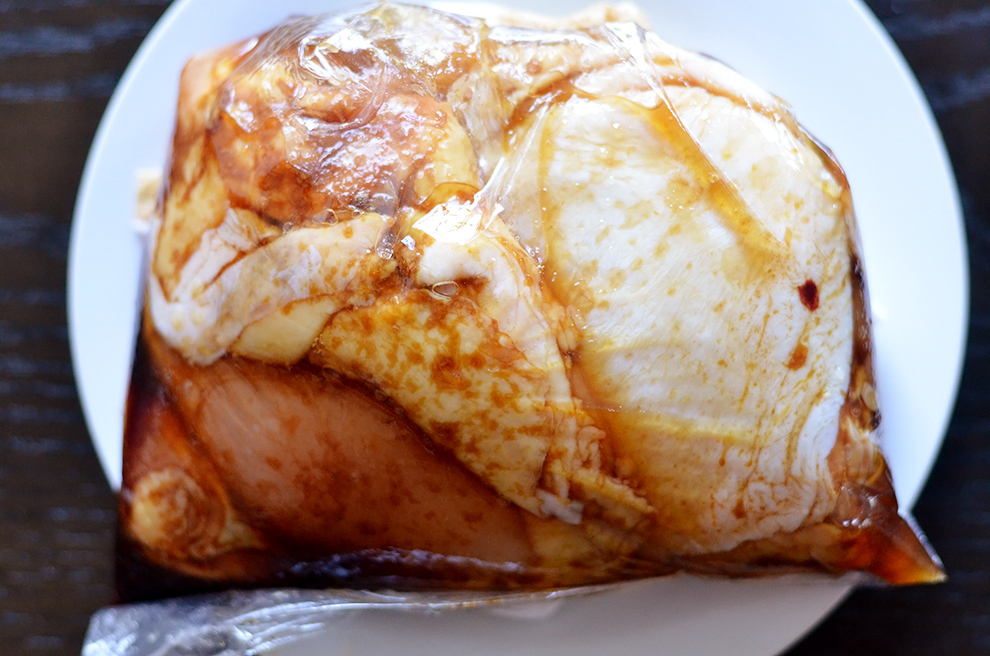
When you cook the chicken thighs, make sure they're not touching.
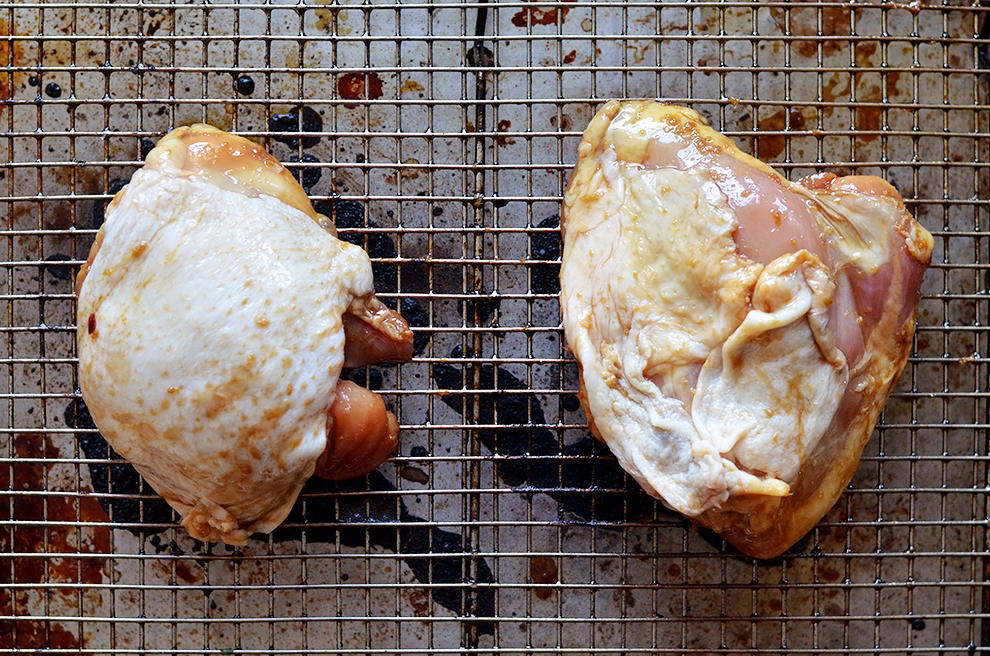
Toasting almonds is tricky. Make sure you don't put too many in the pan at once; they should all be touching the bottom of the pan.
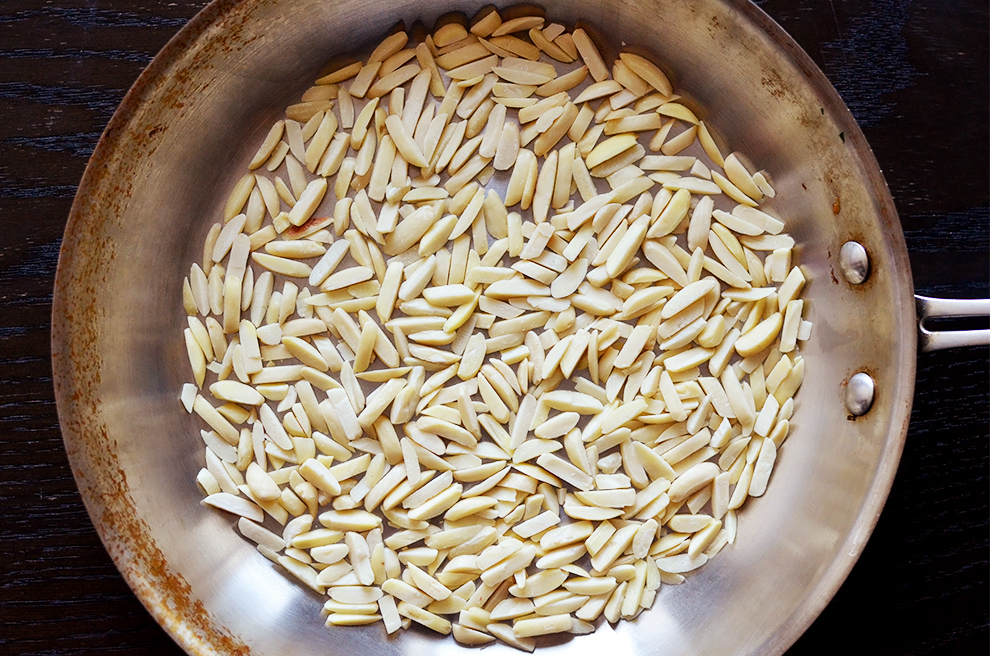
While they're toasting, toss them often. Stop as soon as they look like this:
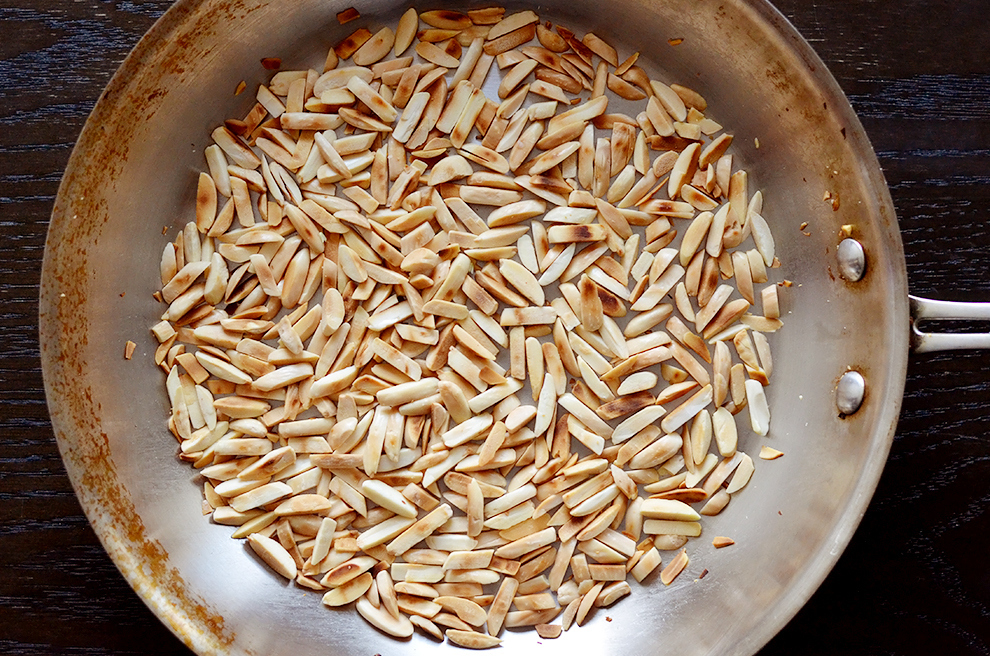
To make the vinaigrette (or any vinaigrette), combine everything but the oil in a bowl.

Then, add the oil really slowly, whisking the whole time.
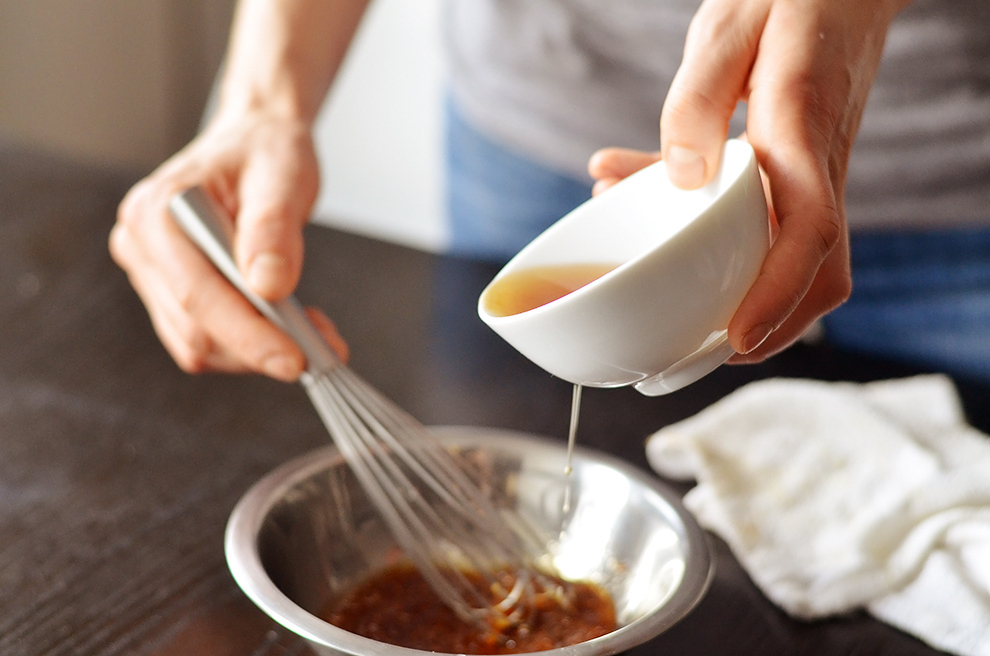
Keep whisking until the oil and the liquid are combined completely.
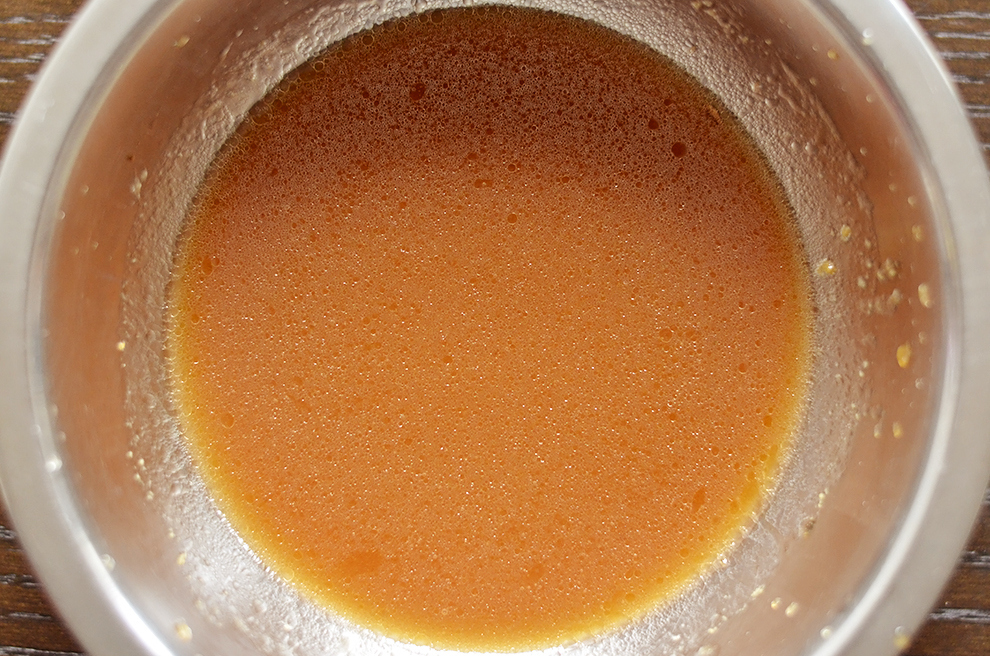
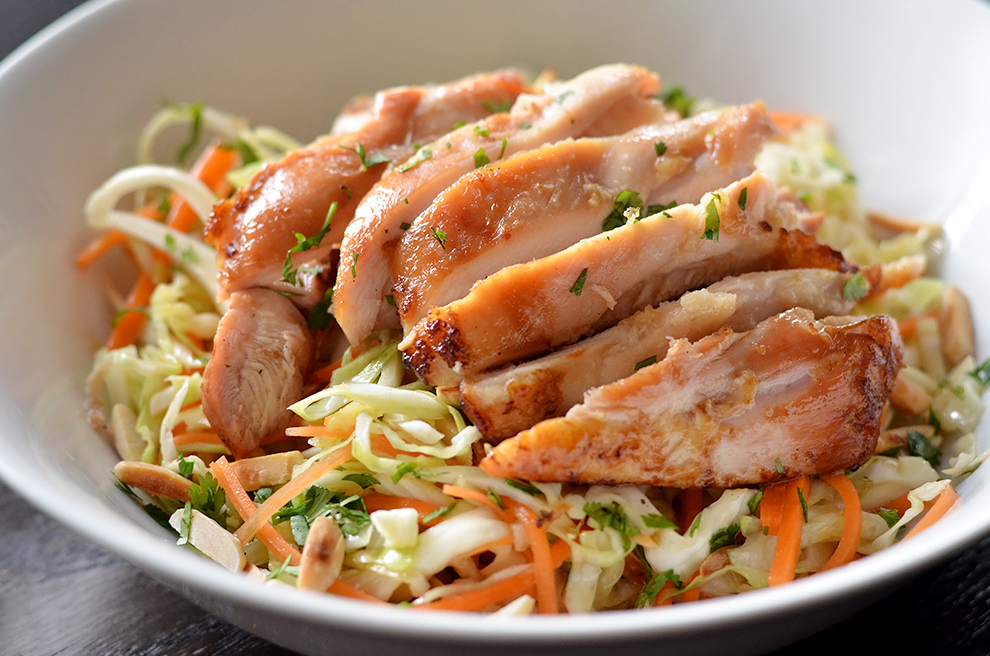
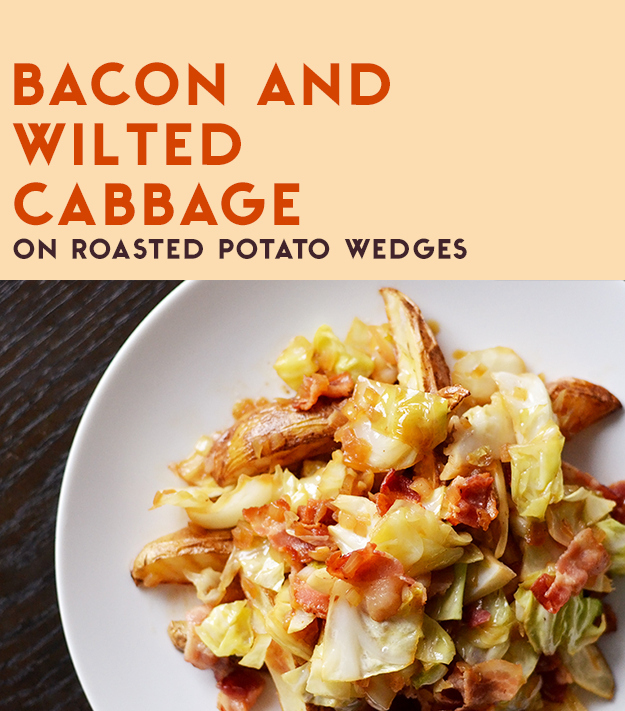
Bacon and Wilted Cabbage on Roasted Potato Wedges
Serves 2
Recipe by Teri Tsang Barrett
INGREDIENTS
8 ounces bacon, sliced crosswise 1/2-inch-thick
1 onion, finely diced
Kosher salt and freshly ground pepper
1/2 head green cabbage — halved, cored and coarsely chopped into 1-inch pieces
1 tablespoon soy sauce
1 pound small russet potatoes (about 3 potatoes)
PREPARATION
Preheat the oven to 450˚F. Heat 1 tablespoon olive oil in a dutch oven over medium-high heat. Add the bacon and cook, stirring occasionally, until crisp, about 8 minutes.
Transfer the bacon to a paper towel-lined plate using a slotted spoon, leaving
the bacon drippings in the pan. Stir in the onion, season with salt and
pepper, and cook, stirring, until the onion softens, about 5 minutes. Stir in the
cabbage, season with salt and pepper, then cook, stirring occasionally, until just
beginning to wilt, 5 to 7 minutes. Stir in the soy sauce, cover the pot and cook, stirring occasionally, until the mixture has softened and is tender though the cabbage will have some bite left in the center, about 15 minutes.
While the cabbage is cooking, cut the potatoes lengthwise into 6 to 8 wedges. Transfer wedges to a large mixing bowl, drizzle with olive oil, sprinkle with salt and pepper, and toss to coat. Transfer to a large baking sheet with a rack, arranging in an even layer. Roast in the hot oven, flipping the wedges halfway through, until crisp, browned and easily pierced with a fork or knife, 25 to 30 minutes.
Stir the bacon into the cabbage mixture. Divide the potatoes between two plates, then top with some of the cabbage mixture. Serve immediately.
When rendering bacon, you can crowd the pan more than you would if you were browning other meat.
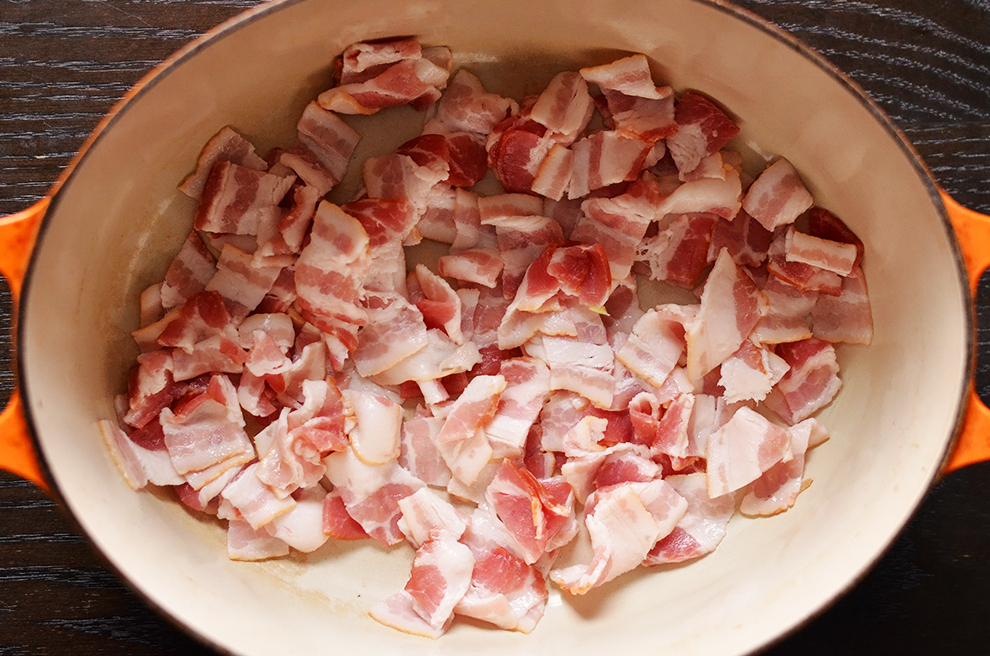
Because, as the fat renders out, it will fry the bacon and cause it to crisp.
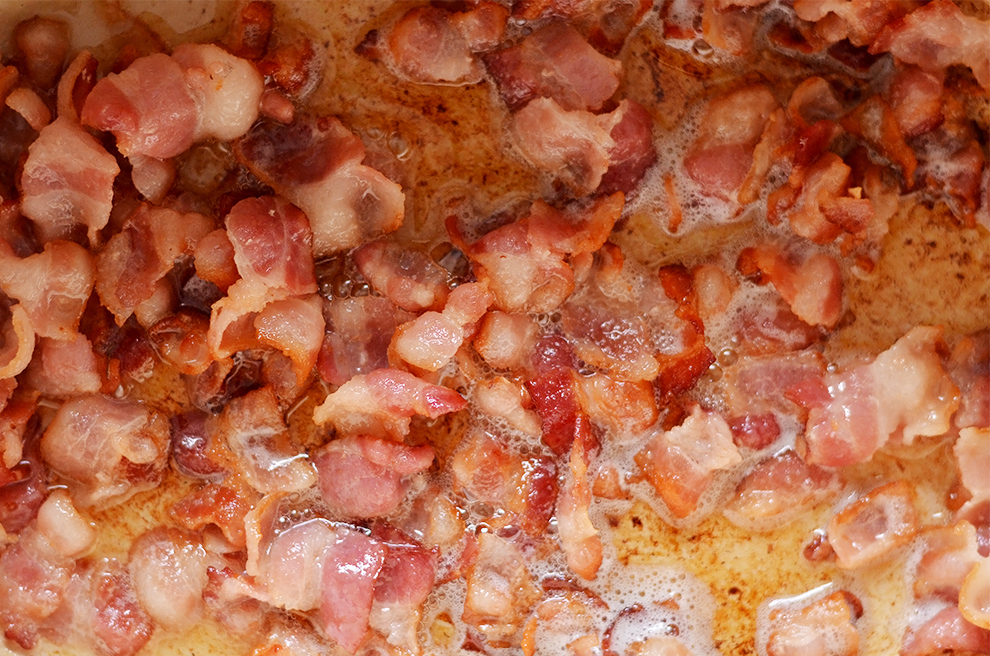
There will be lots of bacon fat left in the pan to cook the onions. You don't have to cook them all the way through, since they'll continue to cook with the cabbage.

Cook the cabbage long enough that it's soft, but not so long that it gets mushy or totally translucent.

Make sure your potatoes are spread out enough on the baking sheet.
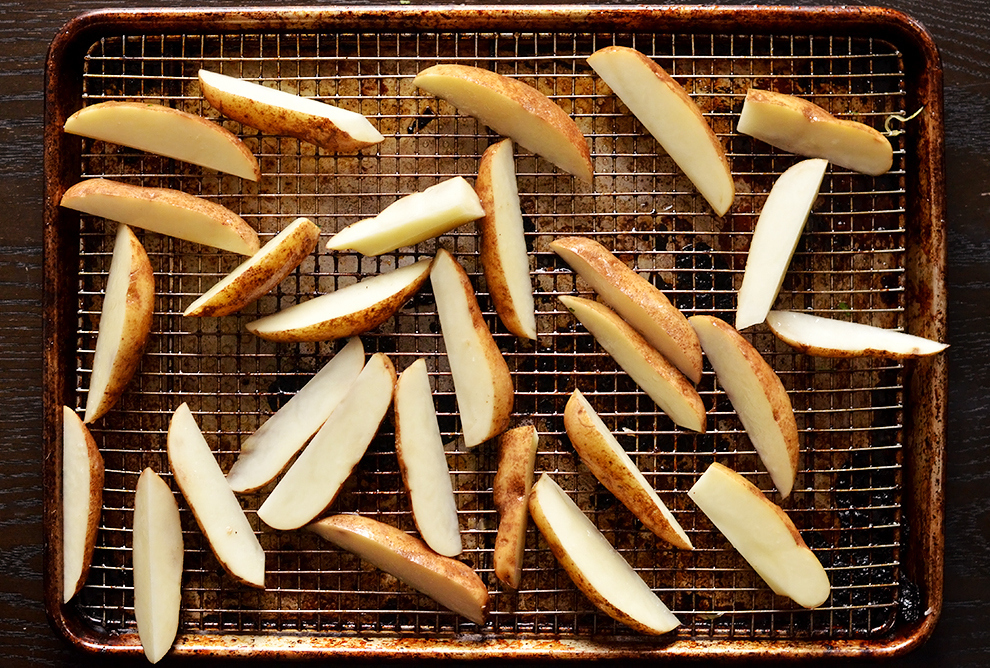
And cook them only until they're crispy, soft, and slightly golden, flipping halfway though.
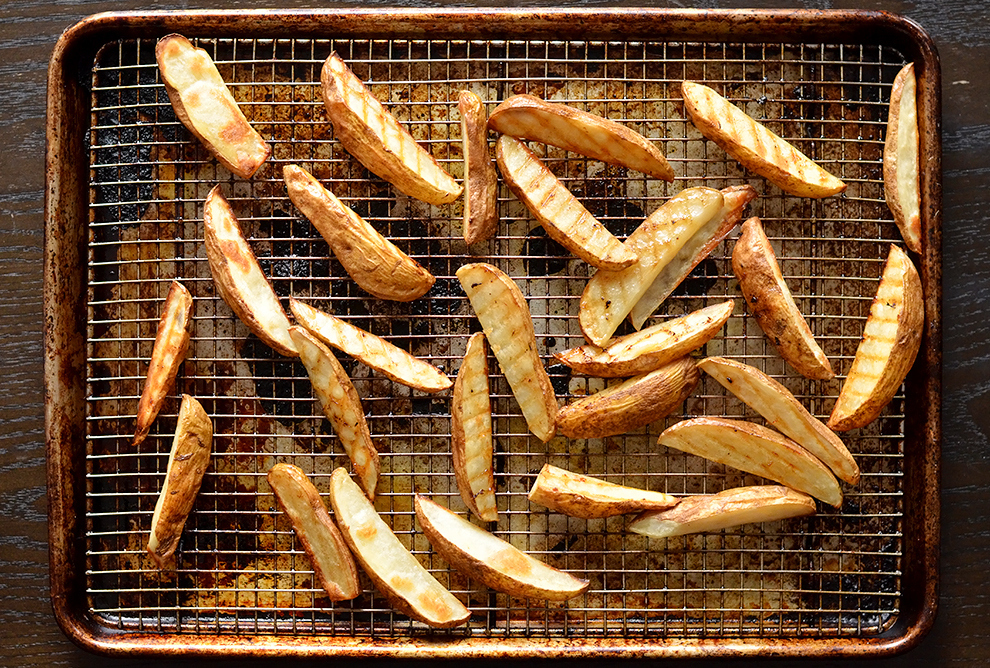
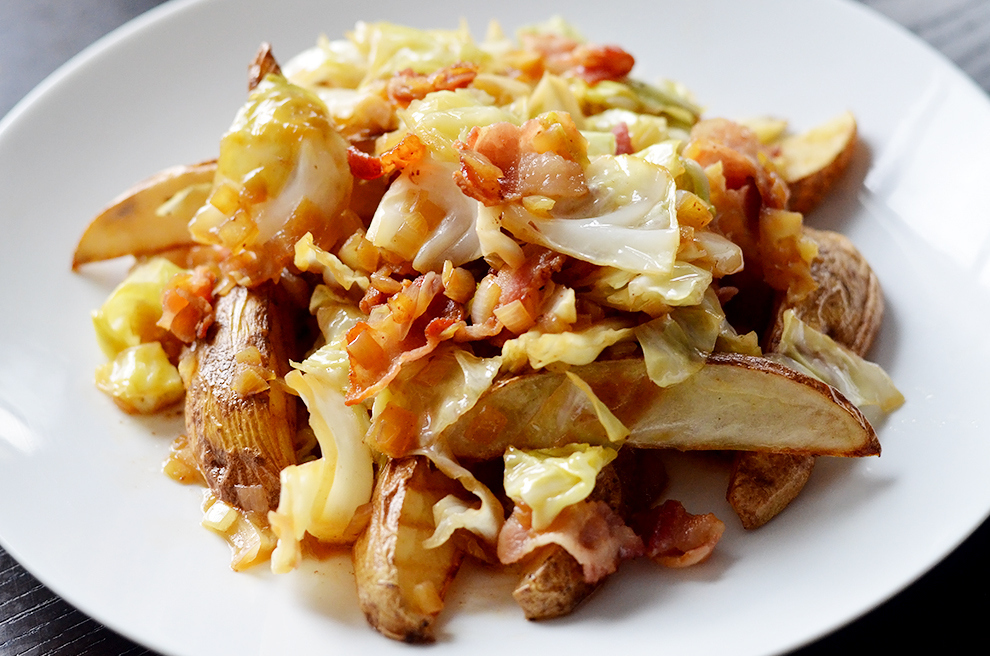

Soba Noodles with Sweet Onions and Fried Egg
Serves 2
Recipe by Teri Tsang Barrett
INGREDIENTS
Extra-virgin olive oil
1 1-inch knob of ginger
2 onions, thinly sliced
6 ounces soba noodles
1/4 cup sesame oil
3 tablespoons soy sauce, plus more for drizzling
1 tablespoon plus 1 teaspoon honey
Cilantro leaves, for sprinkling
PREPARATION
Heat 2 tablespoons olive oil in a medium skillet over medium heat until hot.
Add the sliced onion, season with salt and cook, stirring occasionally, until very soft and starting to brown, 15-20 minutes.
Meanwhile, peel the ginger: Hold the knob in one hand, then hold a spoon in
the other hand and use the edge to scrape off the ginger peel. Finely grate the
ginger; you will need about 2 teaspoons. Set aside.
Bring a pot of water to a boil. Add the soba noodles and cook until tender
according to package directions. Drain, then rinse under cold running water to stop the cooking; transfer to a medium or large mixing bowl.
Heat the sesame oil in a small saucepan over high heat until hot, about 1 minute; flick a small drop of water into the pan — it should spit and sizzle immediately once ready. Add the grated ginger, remove from the heat and cook, stirring, for 30 seconds. Immediately stir in the soy sauce and honey until combined. Pour ginger soy mixture over the soba noodles and toss. Add onions to the noodle mixture and toss again. Divide between two serving bowls.
Heat 2 tablespoons olive oil in a cast iron skillet over medium heat. Once hot, crack the eggs into the skillet. After 30 seconds, turn the heat to low and fry until the edges are crisp and browned and the yolk is warm to the touch but still loose (the yolk should be runny), about 2 minutes. Top each bowl of noodles immediately with an egg, then drizzle with soy sauce and sprinkle with cilantro.
Cook the onions until they're super soft and starting to brown.
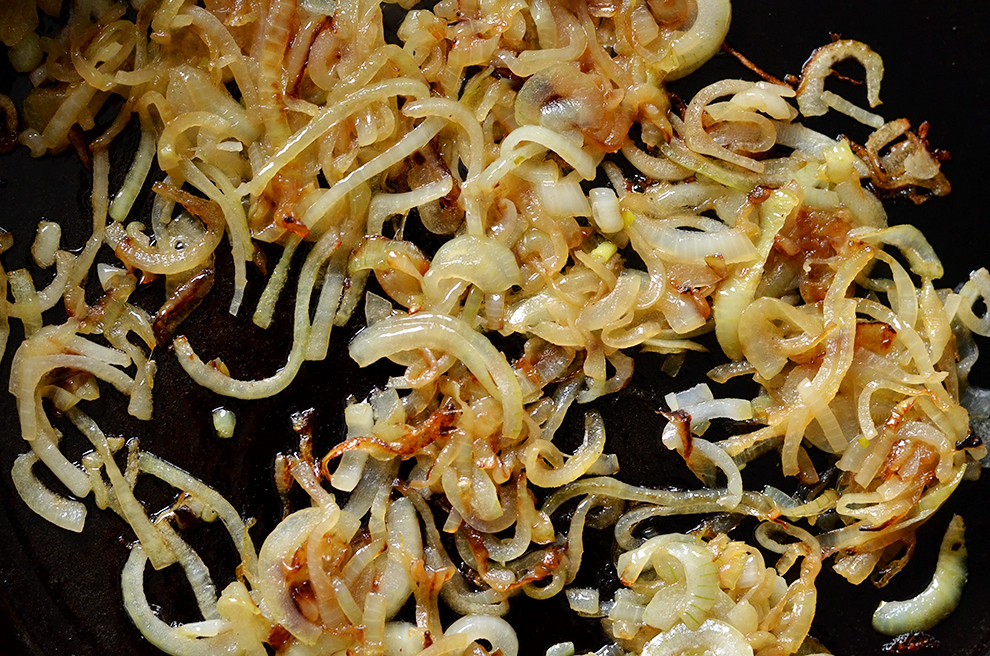
When you take the sesame oil off the heat and add the ginger, it'll start to bubble. Make sure to add the soy sauce and honey before the ginger gets too brown.
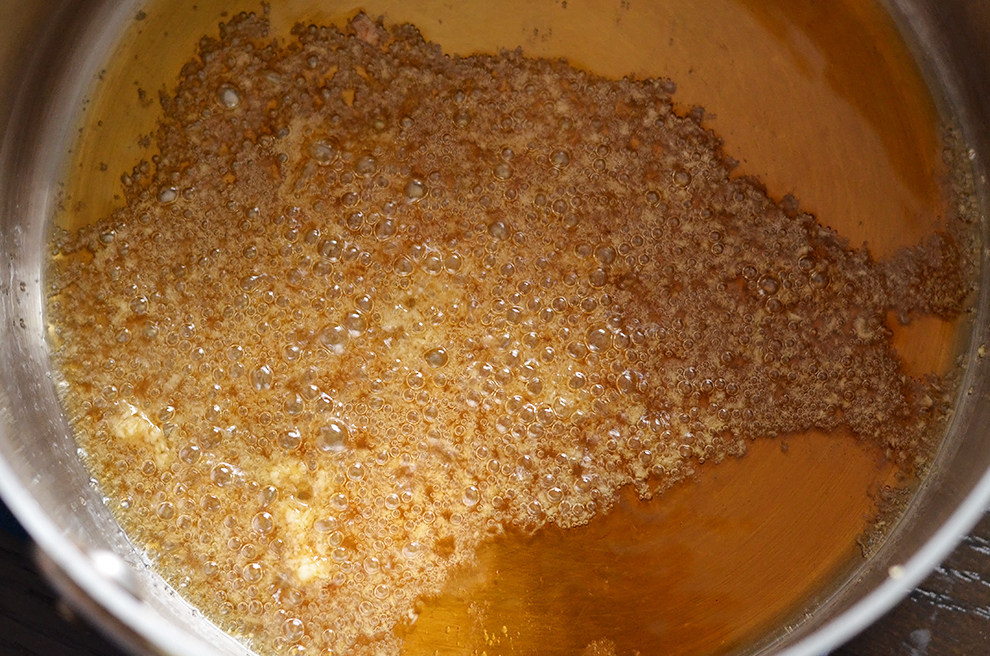
Toss your soba and onions in enough dressing to coat, but not drown, the noodles.
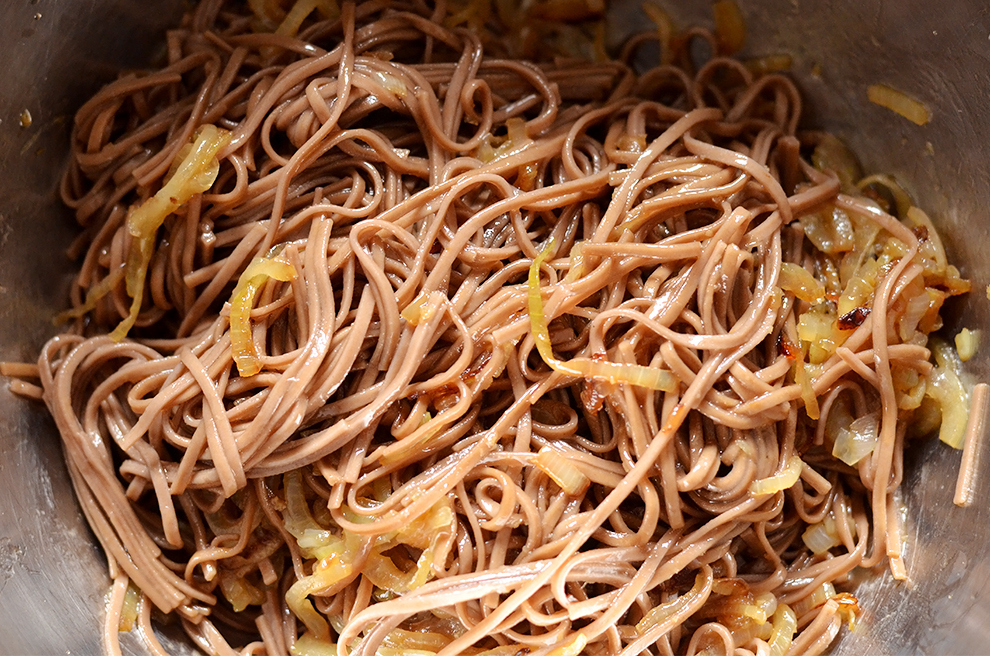
Cooking your eggs over medium-low heat will allow you to cook them long enough to completely set the whites without burning them. The edges should be crispy, but not blackened.
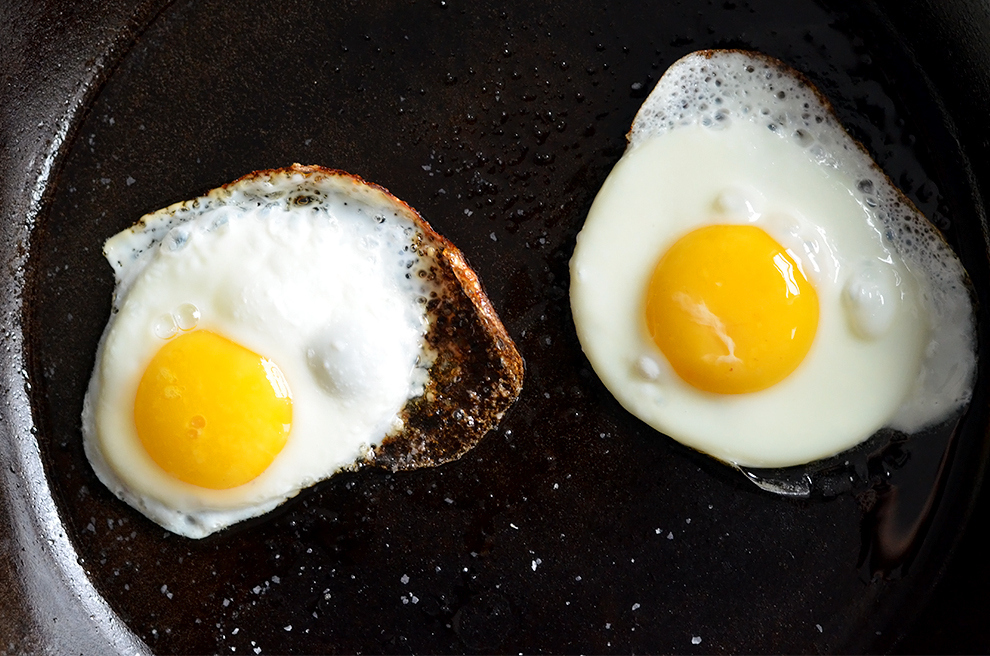
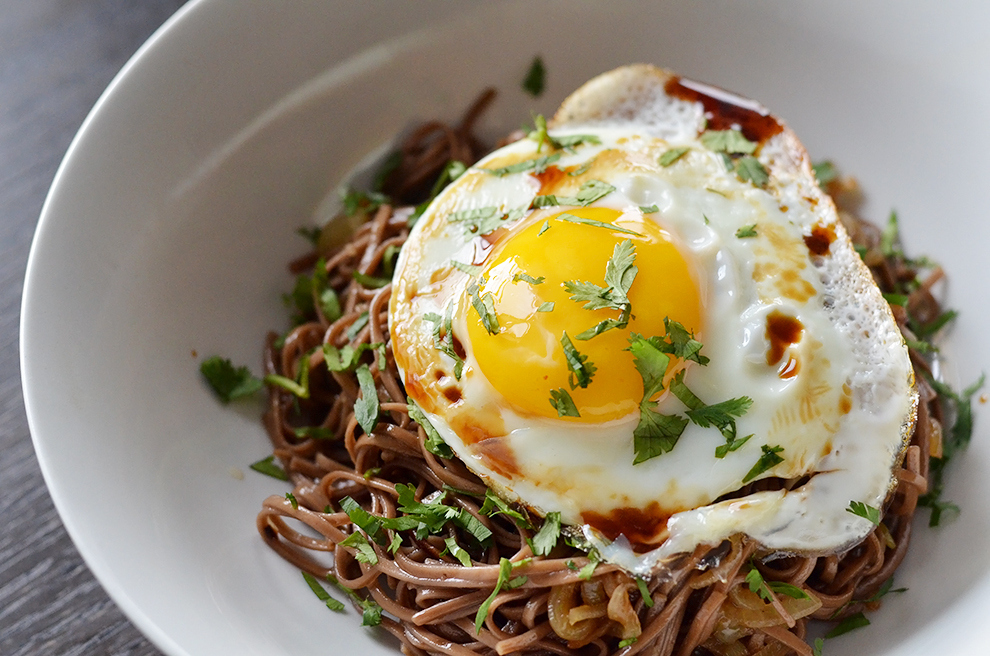
To cook these recipes, you'll use the following equipment.
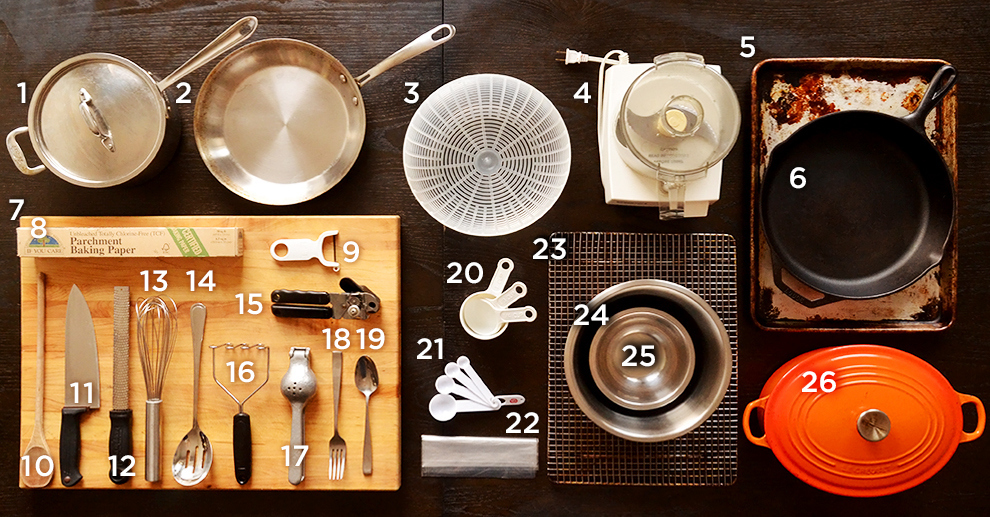
1. Medium sauce pan with lid (8 - 12 inch diameter)
2. 12-inch skillet
3. Colander (or strainer)
4. Food processor (optional)
5. Large rimmed baking sheet
6. Cast-iron skillet (at least 8-inch diameter)
7. Large cutting board
8. Parchment paper (optional, in lieu of a baking rack)
9. Vegetable peeler
10. Wooden spoon
11. Chef's knife
12. Microplane
13. Medium whisk
14. Slotted spoon
15. Can opener
16. Potato masher (optional)
17. Citrus juicer (optional
18. Fork
19. Spoon
20. Measuring cups
21. Measuring spoons
22. 2 Ziploc bags (quart-sized or larger)
23. Rack for baking sheet (optional, you can substitute parchment paper)
24. Large mixing bowl
25. Small mixing bowl
26. Dutch oven (at least 5 quart volume)
